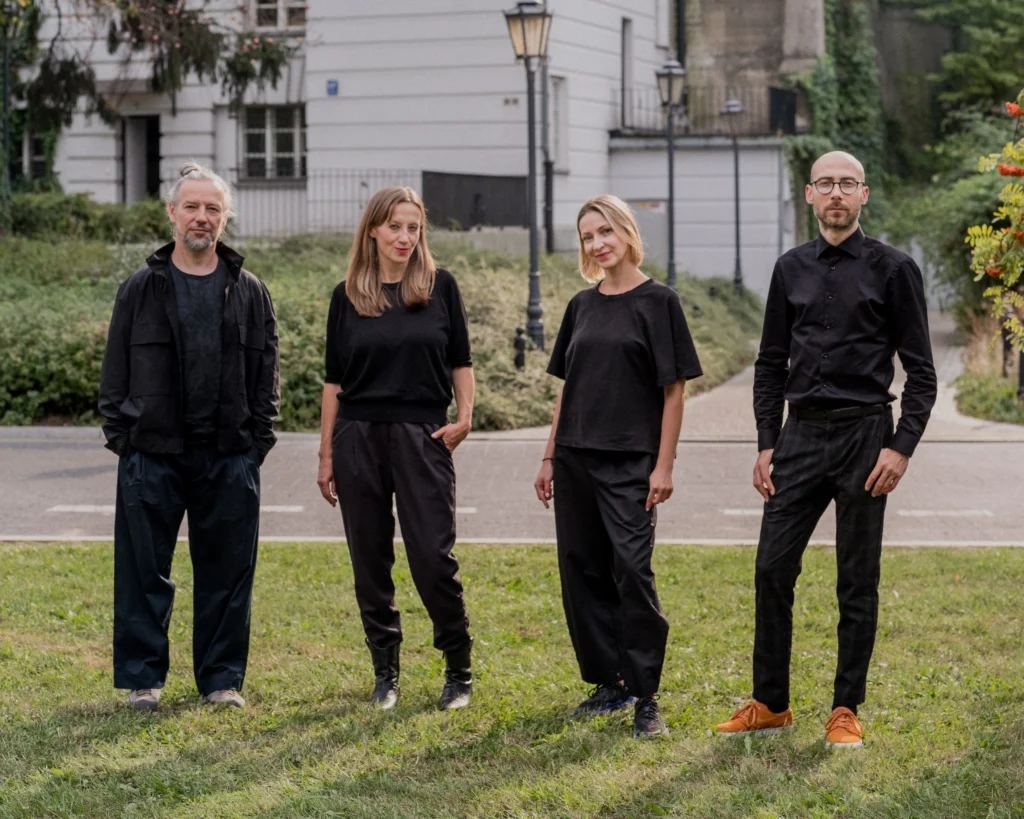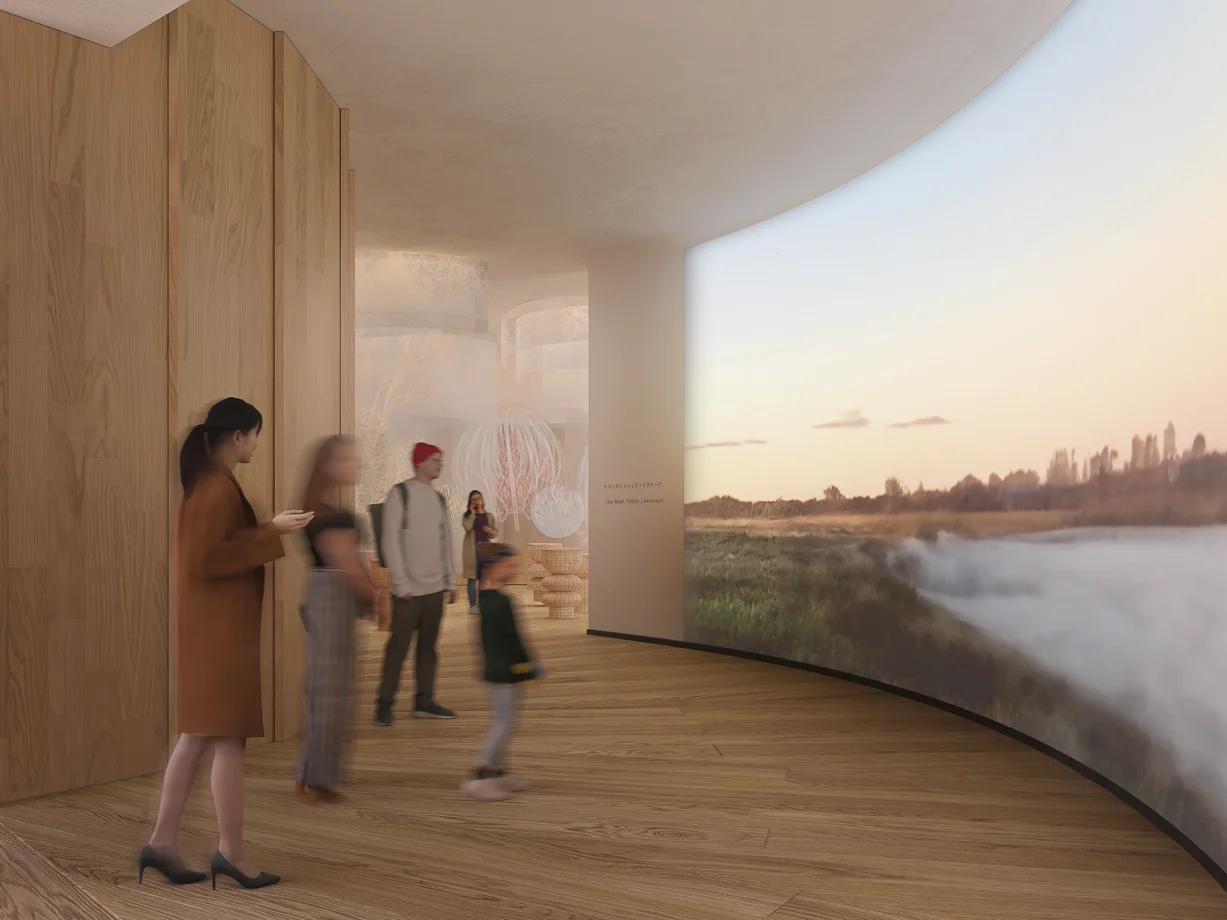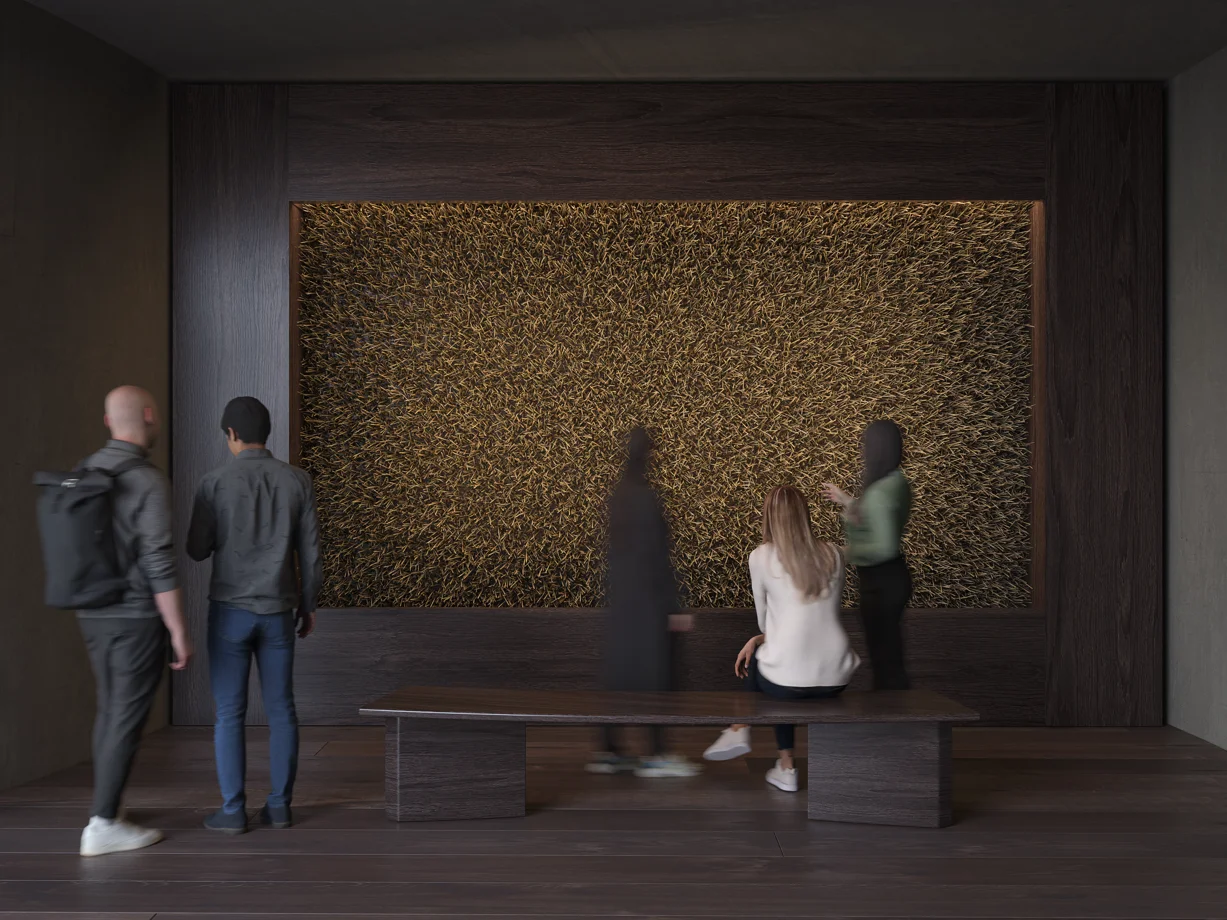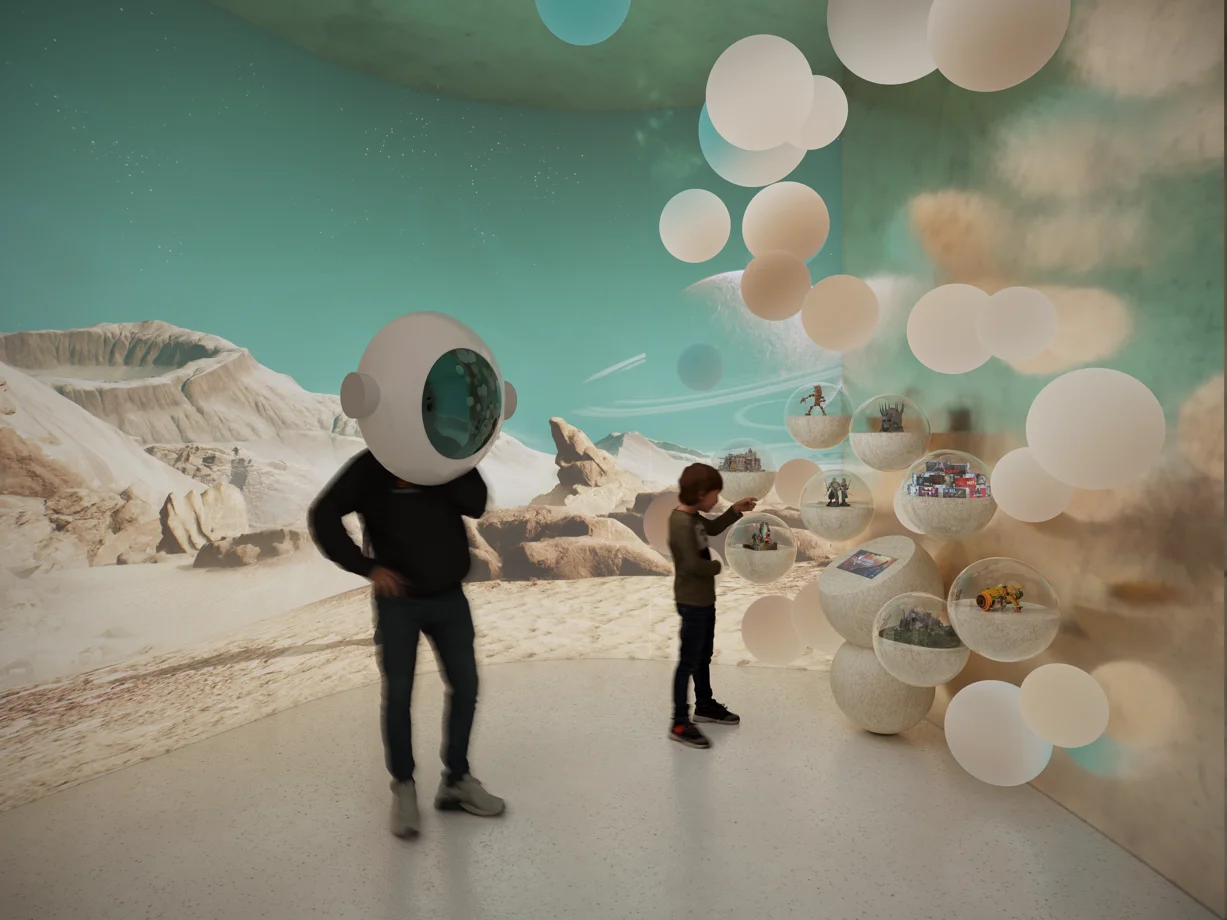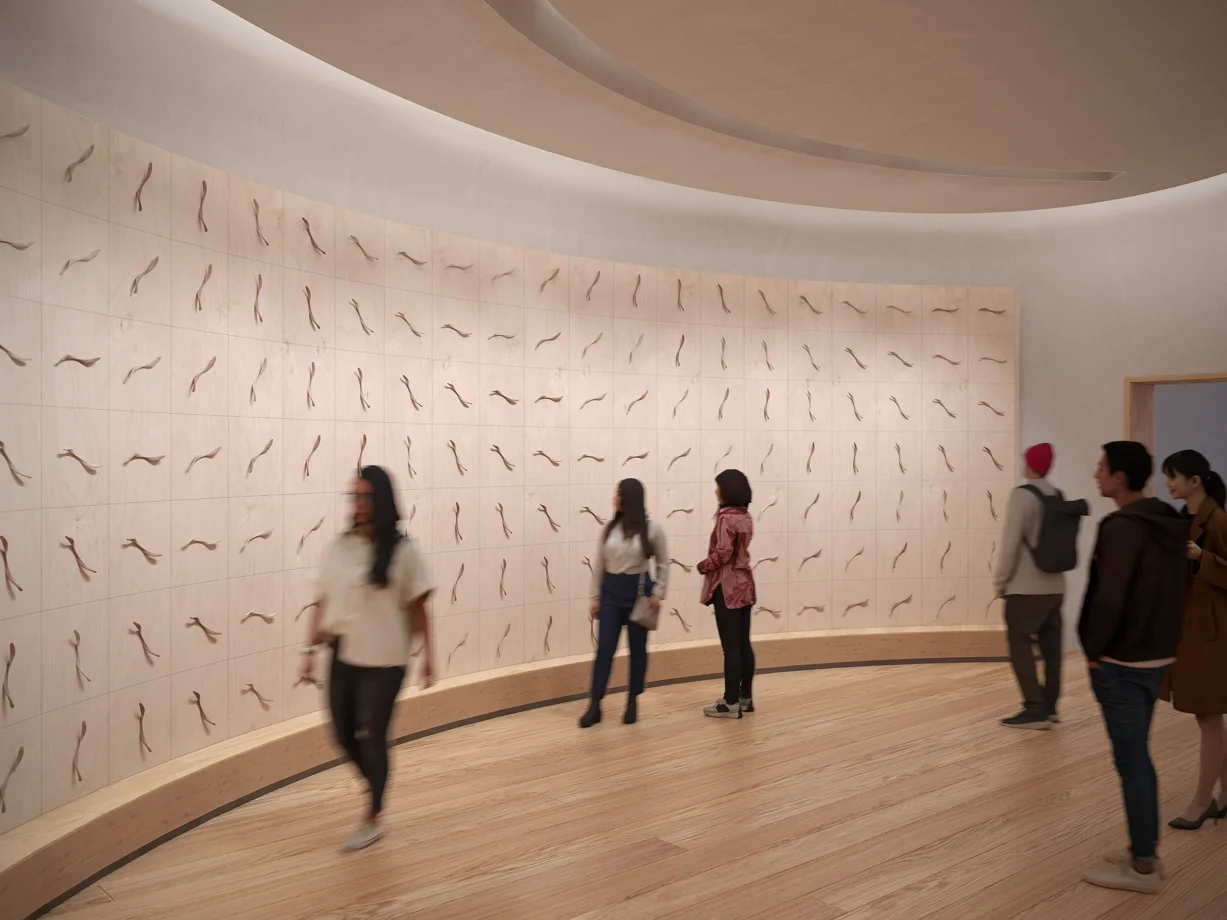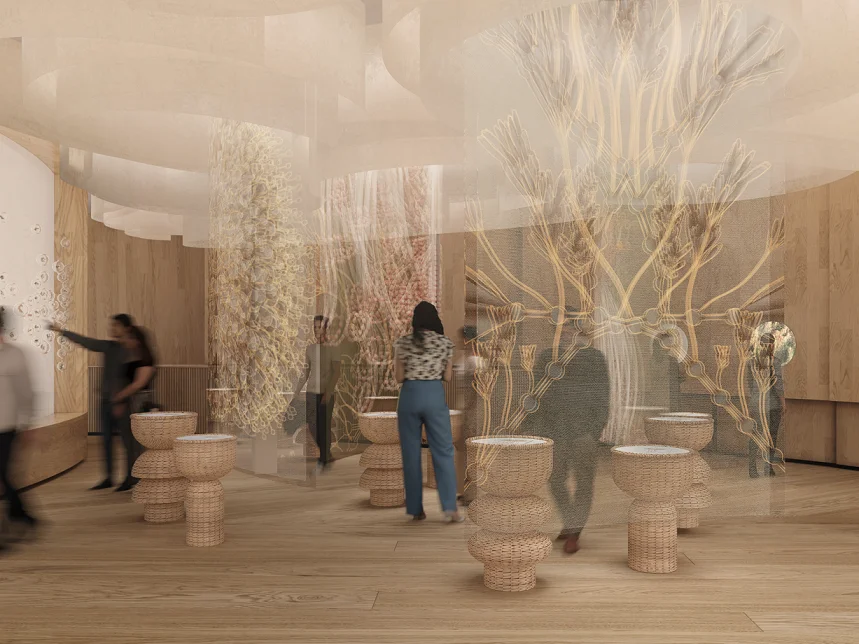Exhibition at the Poland Pavilion – heritage, creativity and AI
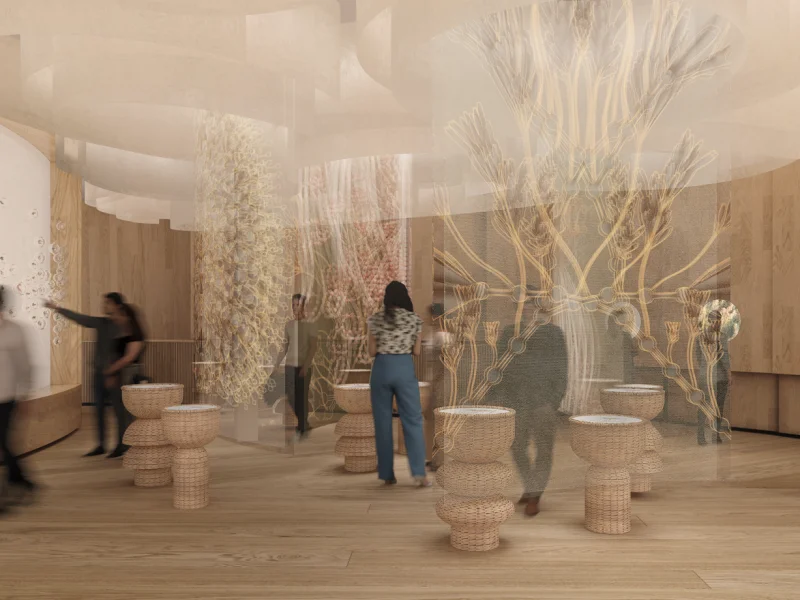
“Heritage that drives the future” is the slogan for the story of modern Poland and its ambitions at the World Expo 2025 Osaka, Kansai. Developed by an interdisciplinary team, the exhibition concept for the Poland Pavilion consists of interactive art installations that showcase the “creativity gene” which is part of the Polish identity. The atmosphere of the space is created by a combination of nature, tradition, science and technology. Its driving force is the visitors, who both experience and co-create the exhibition.
Magical dimension of the exhibition
Visitors will learn in an original way about local herbs and their role in the context of the theme proposed by the Japanese Expo Organisers – “Saving Lives”. They will experience the variability of the Polish landscape and directly feel the influence of humans on its formation, and even “play” an unusual instrument based on craftsmanship. The backdrop of the exhibition will be sounds derived from nature and the soundscape that inspired Fryderyk Chopin, a key figure in the presentation of Polish culture in Japan.
The curators and designers of the exhibition suggest immersing oneself in heritage to better understand the timeless. The artists, combining contemporary digital technology with traditional materials, create a “magical” dimension of the exhibition that will provide visitors with a unique experience.
Innovation and balance
Art installations will introduce visitors to the world of current knowledge and breakthrough innovations, bringing them into a zone focused on the future. There, they will find a map of selected sectors of the Polish economy which are promising in the context of economic exchange between Poland and Japan. Presented on the international stage, examples of Polish start-ups and established companies will serve as an example on how to build economies based on sustainability. Their diversity illustrates Polish companies’ responses to such future challenges as food security, access to energy or raw materials.
Taking inspiration from natural ecosystems, the curators weave stories about Polish companies that are changing their approach to resource use, relying on a circular economy, as well as about businesses that are using the potential of information technology to transform and improve efficiency in various areas of life. Solutions developed by Polish companies draw on both the patterns of nature and the power of technology, the latest discoveries and scientific knowledge. They make it possible to live healthier, safer and more peaceful lives, as well as to shape the environment in ways not possible for previous generations.
Through their interdisciplinarity, both the art installations and the innovative solutions presented at the exhibition not only manifest the Polish spirit of solidarity, but are also evidence of the Polish “creativity gene” passed down from generation to generation. They show how to balance tradition and today’s advanced technology in a wise and sustainable way, safeguarding the future of humans and the Planet.
Pavilion and exhibition
The space for the presentation of Poland at the World Expo 2025 Osaka, Kansai, will be a pavilion of nearly 1,000 m². The Polish Investment and Trade Agency (PAIH) has invited a wide range of artists to carry out the task. The architectural concept, developed by Alicja Kubicka and Borja Martínez of Interplay Architects, is based on the use of wood, and the form of the block is meant to evoke the association with a wave of Polish creativity and innovation spreading beyond the country’s borders. The concept of the permanent exhibition is the responsibility of the curatorial team consisting of: Monika Brauntsch – KAFTI, Ewa Kierklo and Stanisław Kempa – GDYBY, and Wiesław Bartkowski. It was created in cooperation with male and female creators, as well as male and female experts in various fields.
Curatorial team about the exhibition
World Expo theme, Poland Pavilion slogan, Programme Concept, PAIH guidelines. That’s a lot of aspects that needed to be combined. What was the process of working on the exhibition and how did you put all the elements together?
“Poland. Heritage that drives the future” is the slogan of the Programme Concept developed by the Polish Investment and Trade Agency. The concept defines many assumptions crucial to the presentation of Poland at the Expo, including making a reference to Polish heritage and traditions, introducing the composer Fryderyk Chopin, an eminent figure who is also important to the Japanese, promoting Polish innovation and tourism, as well as sectors of the Polish economy. At the same time, themes related to the Expo’s slogan and thematic zones – “Saving Lives” and “Empowering Lives” – were also included. That’s a great deal of aspects that we ultimately managed to combine into a coherent and intriguing story.
When working on the concept of the exhibition, we began by looking for an area of Polish heritage that meaningfully translates into the future, and at the same time would allow us to create an interesting message for the Japanese, who have great respect for their own traditions and cherish them to a much greater extent than we do. As the work progressed, it became clear that the world of plants, mainly herbs, was the starting point for building a coherent story about Poland.
Herbs are both a living tradition and hope for a better future. They carry powerful knowledge and experience of previous generations. They create the potential for us to build good, sustainable progress. The active compounds they contain are valuable material for use in modern medicine, cosmetology, pharmacology and the nutrition industry, all industries on which Poland’s economic programme at the Expo is based. The wide range of applications of the functional properties of wild plants opens up hopeful possibilities for building healthy societies and a healthy future for all of us, which resonates perfectly with the themes proposed by the Expo Organisers. We were struck by the simplicity of herbs. What’s more, it also allowed us to notice converging traditions for Poland and Japan. The knowledge of our expert and author of books on Polish plants – Patrycja Machałek – was invaluable in this.
How long did the entire concept and design process take and how many people are involved in the entire process?
We worked on the concept by design. We built a map of the issues that were included in the concept, as well as those that might be of interest from the perspective of building an installation and tour path. First of all, we had to understand them in depth. It was a situation where good research wasn’t enough: in each of these areas or fields you had to capture something unique that could be turned into an interesting experience. As we explored more threads, we sought out experts and artists to talk to about our ideas.
Work on the exhibition, since the initial concept emerged, has been going on for almost a year and will continue for months to come. That’s almost two years of work. We have been aware of this right from the beginning, so we looked for solutions that two years later would still be surprising and relevant. It was an absolutely fascinating but very exhausting process: there was a great deal of information that we had to process, distil and bundle with the rest of the elements. Of course, a key challenge was also to engage technology and to do so in a subtle and sensitive way, so that visitors could really experience our message, without being overwhelmed or overstimulated.
Your concept involves the use of many modern technologies and innovative solutions in art installations without being obvious. Can you tell us about them?
First of all, we do not put modern technology first, it works in the background, it is invisible, but at the same time makes the ordinary become extraordinary, unprecedented. You could say that the technology working in the background provides the “magic” by turning traditional materials and techniques used by craft artists into unique and individual experiences possible only at the interface of the tangible with the digital, the visible with the invisible, the tangible with computer code, at the interface of atoms with bits. And more literally, we use everything that is most fascinating in the world of modern technology, from artificial intelligence that generates images of non-existent landscapes, through proprietary mechatronic systems that play Chopin, to L‑systems that construct imaginary plants; in a word, a hefty dose of creativity.
What kind of Poland will a visitor to the Poland Pavilion learn about?
Above all, guests will learn about a country that is extremely diverse and creative. This translates into extraordinary ideas of Polish businesses, which are a guarantee of the stability of industries and provide the opportunity to respond to the changing circumstances which we currently experience.
We show that Poland still has its living and cultivated traditions, which we ourselves often forget, but which permeate our reality. Such as herbs, for example: we find them in creative inspirations as well as in every Polish store or home. In the exhibition, they are shown in art installations, but also in the area of sustainable or innovative business solutions.
Another feature is solidarity – which is reflected in interesting collaborations – both between science and business, as well as male and female creators and artists from different fields and areas. By engaging the latest technologies, we also prove that we are an active, constantly learning, open-minded nation. This is demonstrated by the network of unique innovations we present in the “Plantation of Ideas” zone. Through the proposed installations and examples taken from the world of science and business, we show how authentic the creativity of Poles is.
What kind of impression do you think the exhibition at the Poland Pavilion should create among visitors?
We hope that in addition to Polish creativity, solidarity and innovation, visitors will see, above all, something new and surprising. Our installations are built with great sensitivity and refer to features that are common not only to Poles and Japanese, but universal to all people. We are all united by our concern for a better world. We can only build it by respecting what is true, valuable and authentic.
What do you see as the “creative gene” that is written in the DNA of Poles?
To enjoy our heritage to the fullest, we need to understand our roots and also respect our environment. This involves not only respect for society, but also for the nature around us. Characteristics such as innovation, creativity, solidarity and openness create an interesting mosaic of genes that give rise to interesting business and artistic solutions. In our understanding, it is the ability to see and process what is invisible to others.
Meet the creators behind the exhibition concept
Monika Brauntsch
Curator, producer, designer connected with the design industry since 2007.
Co-founder of the award-winning brand KAFTI, presented at many exhibitions; co-founder of The Spirit of Poland Foundation. Since 2011, she has realised dozens of exhibitions presented at design festivals, fairs, as well as in galleries and museums around the world.
Graduate of the Innovation Management and History of Modern Art postgraduate programmes. Winner of the Polish edition of the Young Creative Entrepreneur competition organised by British Council. Co-creator of socially oriented projects. She also provides consulting services, helping companies build more competitive, sustainable and accessible products and services
Ewa Kierklo, Stanisław Kempa – Gdyby
Gdyby is a design studio created by architects Ewa Kierklo and Stanisław Kempa. Their activities are mainly based in the culture, art and museum sectors. They create exhibitions, installations and other mediums of storytelling, with a particular focus on experience design and interactive narratives. Directing the viewer’s impressions and bringing out the symbolic and emotional layers is key for them.
Gdyby has completed projects in cooperation with many recognised cultural institutions both in Poland and abroad.
Wiesław Bartkowski
Complex systems researcher and interaction designer, employee of the University of Warsaw who researches, among other things, how to develop AI to avoid degrading human cognitive abilities. Author of the concept and manifesto “Matter of Code”, which guides his work in the field of art, exploring the emergent properties resulting from the combination of physical and digital matter. Finalist in the exhibition competition for the Poland Pavilion for the International Art Exhibition – La Biennale di Venezia. Fellow of the Centre for Systemic Risk Analysis and the think tank Re-Imagine Europa.
